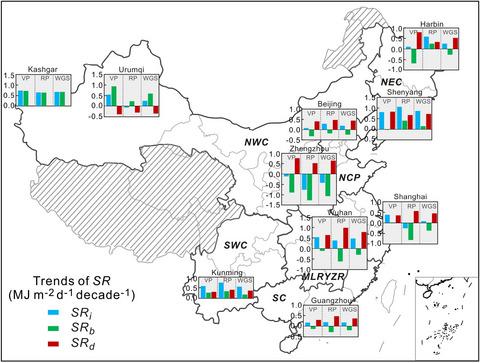当前位置:
X-MOL 学术
›
Food Energy Secur.
›
论文详情
Our official English website, www.x-mol.net, welcomes your feedback! (Note: you will need to create a separate account there.)
From dimming to brightening during 1961 to 2014 in the maize growing season of China
Food and Energy Security ( IF 5 ) Pub Date : 2021-02-06 , DOI: 10.1002/fes3.275 Zhijuan Liu 1 , Xiaoguang Yang 1 , Xiaomao Lin 2 , Zhentao Zhang 1 , Shuang Sun 1 , Qing Ye 3
Food and Energy Security ( IF 5 ) Pub Date : 2021-02-06 , DOI: 10.1002/fes3.275 Zhijuan Liu 1 , Xiaoguang Yang 1 , Xiaomao Lin 2 , Zhentao Zhang 1 , Shuang Sun 1 , Qing Ye 3
Affiliation

|
Climate patterns, cropping systems, and agricultural technologies have greater diversity among various regions in China. Knowledge of the spatial–temporal patterns of solar radiation during the maize growing season is essential for farmers and extension technicians in their optimization of cropping choices and development of adaptation strategies for climate change. In this study, based on the observed solar radiation in six subregions of China, we analyzed the spatial distributions and temporal trends of incident solar radiation (SRi), beam solar radiation (SRb), and diffuse solar radiation (SRd) during 1961–2014. From 1961 to 1984, the annual SRi in most areas showed a downward trend, with a median value of −27.8 MJ m−2 year−1, which is primarily due to a decrease in SRb. However, after 1985, 76% of locations had reversed to brightening. This finding is primarily due to an increase in SRd. The trends in SRi during the whole growing season (WGS) of maize changed by −12.4% to 18.3% during the past 30 years, and 74% of the selected locations showed an increasing trend. At most of the stations, SRb showed a decreasing trend during the WGS, and SRd showed an increasing trend. The trends of SRi, SRb, and SRd during the vegetative period and reproductive period of maize have generally followed a trend similar to the WGSs. Therefore, we conclude that annual solar radiation changed from dimming to brightening from 1961 to 2014 in China. Solar brightening occurred during the maize growing season, which was mainly caused by an increase in diffuse radiation.
更新日期:2021-02-06


























 京公网安备 11010802027423号
京公网安备 11010802027423号